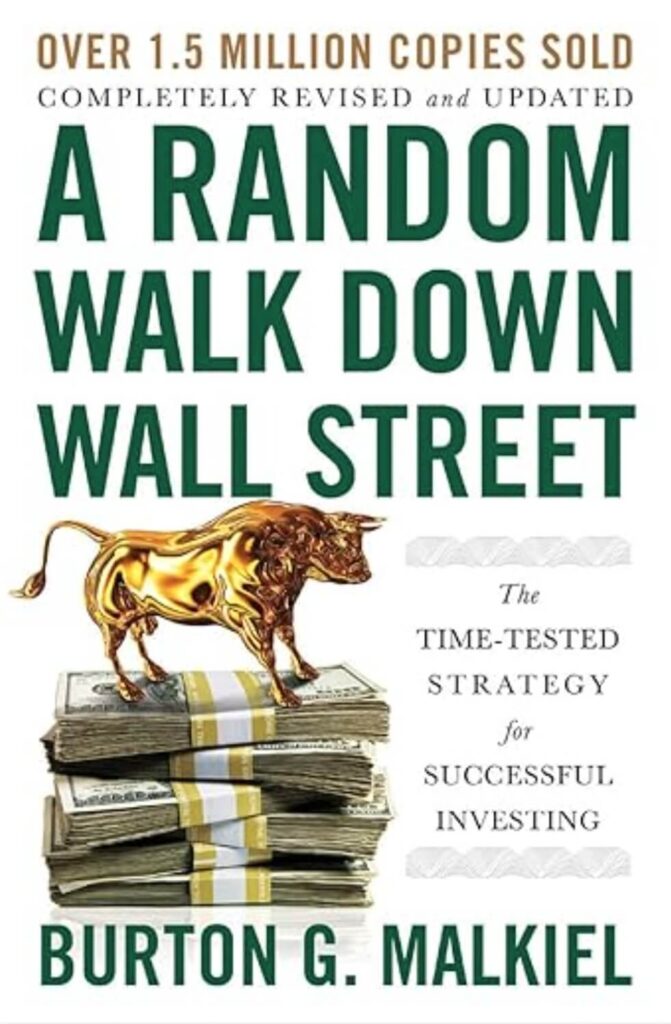If you’re seeking a foundational understanding of investing, A Random Walk Down Wall Street by Burton G. Malkiel offers time-tested advice grounded in decades of financial research. First published in 1973 and now in its 13th edition, this book remains a staple for both novice and seasoned investors.
📌 Why This Book Matters to the Amateur Investor
📉 Markets Are Unpredictable — and That’s Okay
Malkiel’s core message is both humbling and empowering: no one can reliably predict short-term market movements, not even professionals. This is the essence of the “random walk” theory — the idea that stock prices follow an unpredictable path, making it nearly impossible to outperform the market consistently over time.
This may sound discouraging at first. But for new investors, it’s actually liberating. You don’t need to be an expert stock picker. You don’t need to monitor the markets every day. What you need is a low-cost, diversified portfolio and the patience to let it grow over time.
📊 The Power of Passive Investing
One of the book’s strongest contributions is its fierce advocacy for passive investing. Instead of chasing hot stocks or trying to time the market, Malkiel recommends putting your money in index funds that track broad market indices — like the S&P 500. Why? Because study after study shows that most actively managed funds fail to beat the market over the long term, especially after accounting for fees and taxes.
He walks you through historical data, showing that even the most celebrated fund managers often underperform in the long run. As a result, A Random Walk doesn’t just argue for index funds — it turns them into a financial philosophy.
🪙 A Lifetime Strategy, Not a Quick Fix
What sets this book apart from many others is its scope. Malkiel doesn’t just focus on stocks. He covers everything from bonds and real estate investment trusts (REITs) to 401(k)s, IRAs, and life-cycle investing. His advice grows with you — from your first job through retirement. That makes it especially valuable for amateur investors who are thinking not just about “now,” but about building sustainable wealth for the long term.
📚 A Blend of Theory, History, and Practical Advice
Malkiel’s writing seamlessly blends financial theory with real-world examples. He walks you through past market bubbles — from tulip mania to the dot-com crash — to show that speculative frenzy is nothing new. And with each historical lesson, he reinforces the importance of sticking to a disciplined, rational plan.
So if you’re someone who’s ever asked, “What’s the safest way to invest?” or “How do I know I’m not making a mistake with my money?”, this book is an excellent starting point.
💡 Key Concepts That Shape Smarter Thinking
📈 Efficient Market Hypothesis (EMH)
Malkiel explains that all known information is already reflected in stock prices, rendering attempts to “beat the market” futile over the long run.
📊 Index Fund Investing
Advocating for low-cost index funds, Malkiel emphasizes their ability to mirror market performance without the high fees associated with active management.
🧠 Behavioral Finance Insights
The book delves into common psychological pitfalls investors face, such as overconfidence and herd behavior, and offers strategies to mitigate these biases.
⚠️ Technical Sections That May Challenge Readers
While Malkiel’s writing is accessible, certain chapters delve into complex financial theories and statistical analyses that might be dense for readers without a background in economics.
⦁ Technical vs. Fundamental Analysis: Malkiel critically examines both approaches. He argues that technical analysis, which relies on chart patterns and past price movements, lacks empirical support. To illustrate this, he describes an experiment where a chart generated from random coin tosses was indistinguishable from actual stock price charts, highlighting the randomness in market movements.
⦁ Modern Portfolio Theory (MPT): The book introduces MPT, discussing concepts like the capital asset pricing model (CAPM) and the efficient frontier. These sections involve mathematical models and statistical reasoning, which, while foundational to understanding risk and return, may require careful reading for those new to finance.
⦁ Beta and Risk Assessment: Malkiel discusses the concept of beta, a measure of a stock’s volatility relative to the market. He critiques its practical application, suggesting that relying solely on beta for investment decisions can be misleading.
Despite the complexity, these sections are integral to grasping the book’s core message: that markets are largely efficient, and attempting to outperform them through analysis or timing is often futile.
💬 What Online Reviews Say
On Goodreads, A Random Walk Down Wall Street holds an impressive average rating of 4.14 out of 5, based on over 38,000 ratings and 1,700 reviews. Goodreads
Common Praise:
⦁ Educational Value: Many readers appreciate the book’s comprehensive overview of investment strategies and financial theories. It’s often recommended as essential reading for those new to investing.
⦁ Advocacy for Passive Investing: Reviewers commend Malkiel’s clear argument for index fund investing, highlighting its practicality and effectiveness over active management.
Common Criticisms:
⦁ Density of Content: Some readers find certain chapters, especially those delving into technical financial theories, to be dense and challenging without a background in economics or finance.
⦁ Repetition: A few reviewers mention that the book reiterates its core message multiple times, which can feel repetitive.
Overall, the consensus is that while some sections may be complex, the book’s insights are invaluable for anyone serious about understanding investing.
✅ Final Verdict: ★★★★☆ (4.5/5)
A Random Walk Down Wall Street stands as a seminal work in investment literature. Its thorough examination of market theories, combined with practical advice, makes it a must-read for investors seeking a rational approach to the markets. While some sections may challenge readers new to financial concepts, the book’s overarching message—that passive, long-term investing is often the most effective strategy—resonates clearly.
For those willing to engage with its more technical chapters, the book offers a wealth of knowledge that can fundamentally shape one’s investment philosophy.




